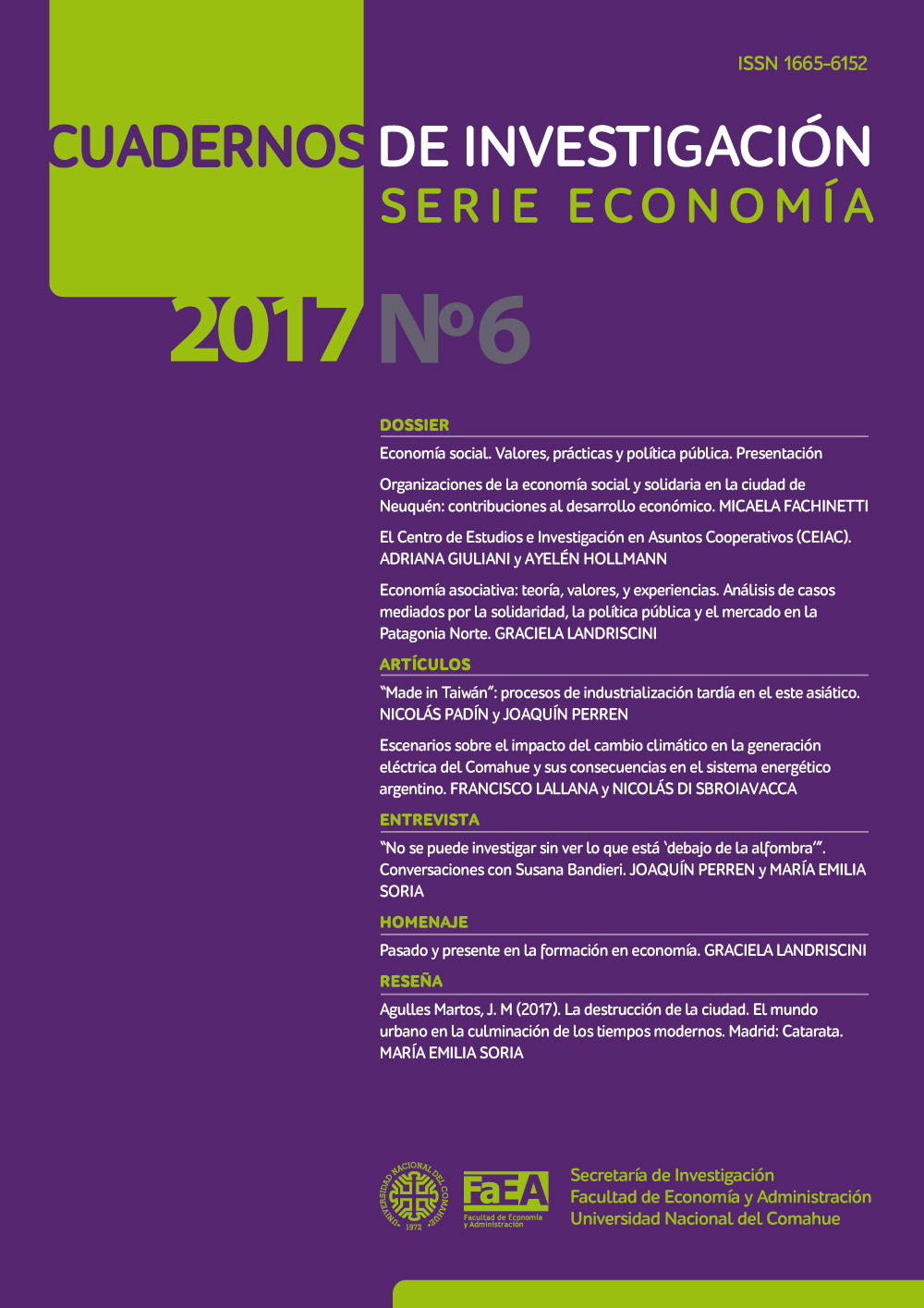“MADE IN TAIWÁN”: Procesos de industrialización tardía en el este asiático
Main Article Content
Abstract
Downloads
Article Details
Licencia: Compartir - copiar y redistribuir el material en cualquier medio o formato.
La licenciante no puede revocar estas libertades en tanto usted siga los términos de la licencia.
https://creativecommons.org/licenses/by-nc-nd/2.5/ar/
References
AMSDEN, A. (2004). “La sustitución de importaciones en las industrias de alta tecnología:Prebisch renace en Asia”. Revista de la CEPAL, Nº 82.
AMSDEN, A., HIKINO, T. y WOLFSON, L. (1995). “La industrialización tardía en perspectiva histórica”. Desarrollo Económico, Vol. 35, Nº 137.
BARBERO, M. I. et al. (2007) Historia Económica Mundial. Del Paleolítico a Internet, Emecé, Buenos Aires.
BEKERMAN, M. y SIRLIN, P. (1997). “Política económica e inserción internacional de Taiwan”. Revista Comercio Exterior, Vol. 47, Nº 6, México.
BEKERMAN, M., SIRLIN, P. y STREB, M. L. (1995). “El “milagro” económico asiático: Corea, Taiwan, Malasia y Tailandia”. Revista Comercio Exterior, Banco Nacional de Comercio Exterior, Vol. 45, Nº 4, México.
CAMERON, R. (1996) Historia Económica Mundial. Desde el Paleolítico hasta el Presente, Alianza, Madrid.
CHANDLER, A. (2008) La mano visible. La revolución de la gestión en la empresa norteamericana, Ediciones Belloc, Barcelona.
GALBRAITH, J. (1999) Historia de la economía, Ariel, Buenos Aires.
GERSCHENKRON, A. (1968) El atraso económico en su perspectiva histórica. Ariel, Barcelona.
HOUTART, F. (2002). “Los NICs: “modelos” para (des)armar”. Temas, Nº 29, Cuba.
JUNG TZO L. (2008). “El desarrollo económico y tecnológico de Taiwán”. Perspectiva, N°53, edición 10.
KAY, C. (2002). “Reforma agraria, industrialización y desarrollo: ¿Por qué Asia Oriental superó a América Latina?”. Debate agrario: análisis y alternativas, Centro Peruano de Estudios Sociales, Lima.
MADDISON, A. (1998) Historia del desarrollo capitalista. Sus fuerzas dinámicas. Una visión comparada a largo plazo, Ariel, Barcelona.
MARX, C. y Engels, F. (2000) Manifiesto Comunista, El Aleph, Buenos Aires.
MORISHIMA, M. (1984) ¿Por qué ha triunfado Japón?, Crítica. Barcelona.
NORTH, D. (1984) Estructura y cambio en la historia económica, Alianza, Madrid.
PEEMANS, J. P. (1988). “El sudeste asiático entre el mito y la realidad”. Cuadernos de Economía, Volumen 9, N° 12, pp. 21-55, Universidad Nacional de Colombia, Bogotá.
PERREN, J., TEDESCHI CANO, G. y CASULLO, F. (2014) De pioneros, seguidores y descolgados. Industria y crecimiento económico en el siglo XIX, EDUCO, Neuquén.
TORIJA ZANE, E. (2012). “Desarrollo industrial y política macroeconómica de los dragones asiáticos”. Documentos de Trabajo, CEPAL-BCRA, Santiago de Chile.
TOUSSAINT, E. (2006) Banco Mundial. El golpe de Estado permanente. La agenda oculta del Consenso de Washington, El Viejo Topo, España.
SEVARES, J. (2010) Por qué crecieron los países que crecieron, Edhasa, Buenos Aires.
SCHUMPETER, J. (1961) Capitalismo, socialismo e democracia, Editora Fundo de Cultura, Rio de Janeiro.
STIGLITZ, J. (1997). “Algunas enseñanzas del milagro del este asiático”. Desarrollo Económico”, Nº 147, Buenos Aires.
VILAS, C. (2002). “La piedra en el zapato: Estado, instituciones públicas y mercado”, En: CAMPOS ARAGÓN, L. (Coord.), La realidad económica actual y las corrientes teóricas de su interpretación, UNAM, México.
WEBER, M. (1979) La ética protestante y el espíritu de capitalismo. Premia Editores, México
